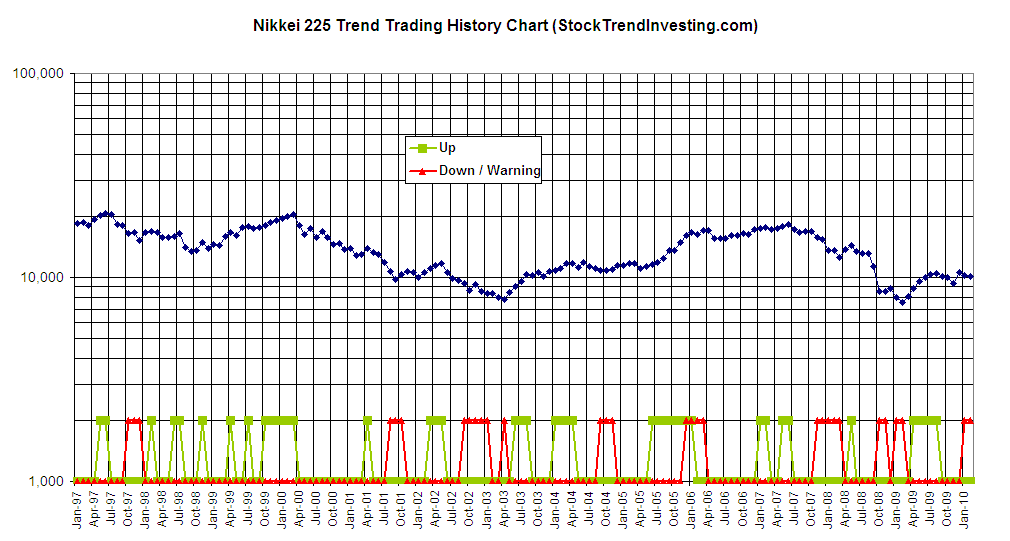March 2010
Stock Exchange Trend
Submitted by Van Beek on March 20, 2010 - 04:48The stock exchange trend is the trend in the index of that stock exchange. Each stock exchange has its own index. This is a composite of a number of important stocks that are listed on that stock exchange.
Stock Trend Investing follows the stock exchange trend for a number of important stock exchanges around the world. For the US for example, the NYSE and NASDAQ stock exchanges are covered. But we cover as well as the Dow Jones and S&P 500 indices.
Note that these last two indices are indices that are composites of stocks that are listed on the first two mentioned stock exchanges. However, they are not the index of that stock exchange. We also cover the trends of at least 4 European stock exchanges and 4 Asian stock exchanges.
Stock Market Trend Analysis
Submitted by Van Beek on March 19, 2010 - 17:34Stock Trend Investing is specialized in Stock Market Trend Analysis. Every month we analyse and review the trends in a number of major stock market indices. Yes, we review it every month, not every day. The reason for that is that the typical user of the Stock Trend Investing system does not have time to trade every day. Our users only want to spend maximum one hour per month on their investments.
Therefore, Stock Trend Investing is performing a specific monthly stock market trend analysis. If the user of the analysis only wants to trade once per month, the analysis has to be targeted to that. Likewise, a trend investor who wants to trade every day needs a daily stock market trend analysis.
Nikkei Historic Trend Trading Chart - February 2010
Submitted by Van Beek on March 18, 2010 - 07:42Every month, Stock Trend Investing is publishing one of its historic trend trading charts for free. This month, it is the trend trading chart or the Nikkei 225, the index of the Japanese stock market in Tokyo.
The blue line shows the closing price of the Nikkei index for that month.
The green line signals when our Initial Trend Expectation for the Nikkei was "Up". The red line signals when our Initial Trend Expectation for the Nikkei was "Down" or when there was a special warning.
Log in or register on this website to download the chart at the bottom of this page. You can also click and drag the chart to a tab in your browser to see an enlargement.

Stock Trend Signal
Submitted by Van Beek on March 17, 2010 - 16:46A Stock Trend Signal indicates the current trend in the stock market. Stock Trend Investors use stock trend signals to decide when to invest in the stock market and when to sell the equities they hold.
In the Stock Trend Investing system, we have stock trend signals that show us every month if we expect the market index to go “Up”, to go “Down” or to be “Unclear”. An “Unclear” signal means that we do not see a clear trend up or down.
The stock trend signals for individual stock market indices are called Initial Trend Expectations. At Stock Trend Investing, we cover a number of major stock market indices in the US, Europe and Asia.
Trading currencies or how to deal with currency fluctuations
Submitted by Van Beek on March 17, 2010 - 02:51There is a recent trend that non-professional investors step into the currency trading. The major shifts that the US dollar has made versus the Euro during the last year are probably the reasons for this. Why should you be very, very careful before starting to trade in currencies and what can be the impact of currency fluctuations on investors in stocks and funds.
The exchange rate between currencies is developing 24 hours per day. This exchange rate is the price you need to pay in one currency for another. For example, at the time of writing, one needs to pay 1.37 US dollar for every 1 Euro.

Market Timing Mutual Funds
Submitted by Van Beek on March 16, 2010 - 10:08Market timing for mutual funds is crucial for being successful with investing in mutual funds. Stock Trend Investing is focused on giving market timing signals for investors in mutual funds and index funds.
Different market timing systems have different timing horizons. Some look at the timing within a few hours, others look at the market timing within a few days or weeks. Stock Trend Investing considers the longer term trends that are expected to last a few months or even a few years.
Members of the Stock Trend Investing community review their positions only once per month. This is especially suitable for people who cannot or do not want to spend every day or week a certain amount of time on their investments.
What percentage of your stock investments is outside your own currency zone?
Submitted by Van Beek on March 16, 2010 - 08:49Trend Trading
Submitted by Van Beek on March 13, 2010 - 14:19Trend trading is a generic term for a number of different approaches that are used to invest in the stock market. Stock Trend Investing is a form of trend trading. In this article we will high light the differences between our form of trend trading and other existing alternatives.
Different trend trading systems focus on trends of different lengths. Stock Trend Investing focuses on long term trends that are expected to last at least a number of months, but sometimes years. Members of the Stock Trend Investing community review their positions only once per month. This is especially suitable for people who cannot or do not want to spend every day or week a certain amount of time on their investments.
Outsourcing your wealth management or keeping it in-house
Submitted by Van Beek on March 9, 2010 - 07:03When do you outsource something in your business and does the same apply for your wealth management? In business you outsource those activities that someone else can do better and that are not a core competence to your organization. So, how does the management of your wealth stack up to that?
Is it part of your core competences or should it be? It is probably not part of your core activities when you look at how much time you want to spend on it. If an hour per month would do, that would be great. You prefer to spend your time on other matters. But managing your wealth is pretty important, isn’t it. It is your future.

Should Stock Trend Investors show patience or bold action during March
Submitted by Van Beek on March 2, 2010 - 05:53Do you know now how the Asian, European and US stock markets did during February 2010? Did they go up or down and how shall someone investing in stock market trends take action on these developments? Here is an easy overview.
In summary, the main US markets went up during February, the main European markets went a little down, except for the UK and the Asian markets went up except for the Japanese Nikkei.

- « first
- ‹ previous
- 1
- 2
- 3

